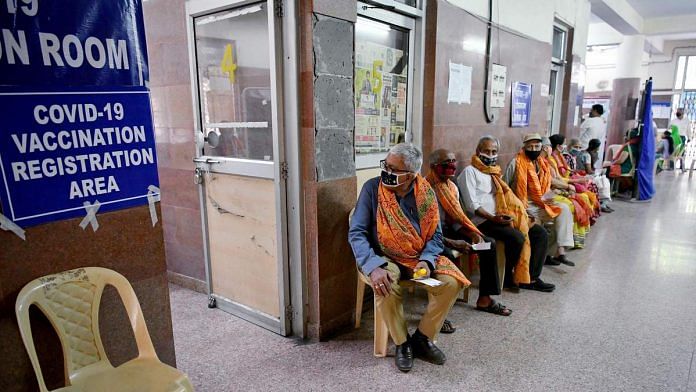Mumbai: India is running out of vaccines just as a new wave of Covid-19 infections batters the country, complicating Prime Minister Narendra Modi’s plan to inoculate the nation’s workforce while threatening to drag out the world’s worst health-care crisis.
In the financial hub of Mumbai, vaccinations began later than usual on Monday as vials ran low. The city has enough stock for the next three days but those getting their second dose will be accorded priority, the municipality said in a statement. This shortage is likely to get acute starting May 1 when the government plans to allow adults between the ages of 18 and 45 to get the jab, in addition to the ones above 45 that are eligible currently.
India is still struggling to get back on its feet as overwhelmed hospitals ran out of oxygen while new cases have risen to about 3.5 million since mid-April. Vaccine production has also been hit by the stockpiling of certain essential raw materials by the U.S.
In a tweet Sunday, President Joe Biden signaled help is on the way. Ingredients needed to produce Covishield, the Oxford University-AstraZeneca Plc vaccine made in India, have been identified and “will immediately be made available,” Emily Horne, a spokesperson for U.S. National Security Adviser Jake Sullivan, said in a statement.
India reported an unprecedented 352,991 new infections and 2,812 deaths on Monday for the prior 24 hours, though the actual toll may be much higher. These grim scenes are likely to continue for about a month, according to Ramanan Laxminarayan, director at the Center for Disease Dynamics, Economics & Policy in New Delhi.
“The latest epidemiological projections are that the peak won’t be reached for another two or three weeks nationwide,” Laxminarayan told Bloomberg TV on Monday. “The projections that are being used are that the peak will be at the point where the numbers will probably be three or four times that we have right now.”
BMC has received 1.5L vaccines today
New stock will ensure smooth vaccination process at most CVCs for at least next 3 days
Owing to limited stock, Covaxin will be available at select centres for 2nd dose
Expect delayed starting of vaccination tomorrow. Cooperation requested.
— माझी Mumbai, आपली BMC (@mybmc) April 25, 2021
Also read: Not vaccine supply, distribution by states also the problem in slowing phase one, says govt
Sankaran Punneri Peroor, 66, took his first dose on March 4 and is running out of time for the second. Several clinics canceled his appointment citing low stocks. On Monday morning, Peroor and his wife were among more than 100 people standing for hours under a scorching sun at the Maasaheb Meenatai Thackeray Hospital in Navi Mumbai. The hospital’s vaccination target for a day is 200.
“I managed to get admission in another private clinic which is 10 kilometers away from my residence. But on the vaccination day, the registration itself was canceled,” Peroor said. “I am pursuing all efforts as the coronavirus is spreading like wildfire.”
The latest wave of infections, which Modi called a “storm,” follows an unexplained lull earlier this year, during which India exported or gifted more than 60 million doses of its vaccine.
The resurgence in cases is also threatening to hinder the recovery of the $2.9 trillion economy, which slid into a recession last year because of lockdowns. Modi is reluctant to back a nationwide lockdown this year, but has left it to local governments to decide on measures needed to curb the spread of the virus.
The country’s two main cities — Mumbai and capital New Delhi — have already imposed tight restrictions on movement of people. The latter extended its lockdown through May 2. The state of Maharashtra, home to the nation’s financial hub, tightened its curbs last week.
The lockdowns are making it harder for citizens to commute and access vaccination centers, adding another layer of challenge.
The Sanjay Gandhi Memorial Hospital in New Delhi, which has the capacity to vaccinate at least 600 people a day, is seeing only around 400 turn up, according to medical superintendent P.S. Nayyer.
Mumbai’s so-called Jumbo Centre in Bandra Kurla Complex, which houses the Indian headquarters of global banks and a stone’s throw from the U.S. Consulate, had to suspend its shots on April 25 when it ran out of doses before supplies came in.
“We have restarted our vaccination drive since morning,” said Rajesh Dere, dean of the facility, adding 200,000 people have had their jabs at his center since the start of the program.
Additional help is also coming from the U.S. Development Finance Corporation. The agency will fund an expansion of the production capability of Indian vaccine maker Biological E Ltd., or BioE, to at least 1 billion doses by the end of 2022. Ventilators, therapeutics, rapid-test kits and personal protective equipment will be sent as well, according to the statement from Sullivan’s office.
Separately, on ABC’s “This Week” program on Sunday, Anthony Fauci, head of the National Institute of Allergy and Infectious Diseases, said the U.S. will consider sending India stockpiled doses of the AstraZeneca vaccine currently unapproved for use in the U.S. He also cautioned he didn’t “want to be speaking for policy right now.”
At a Monday event, the head of the World Trade Organization, Ngozi Okonjo-Iweala, urged rich nations to export more vaccines to ensure poorer countries aren’t left behind if the world wants to get through the pandemic.
“The shortage of Covid-19 vaccines in India is an early warning,” said Chandrakant Lahariya, a New Delhi-based expert on public policy and health systems. “It reminds policy makers to do better planning and iron out the challenges identified.” – Bloomberg
Also read: From vaccines to oxygen, Centre-state volleyball needs to end



